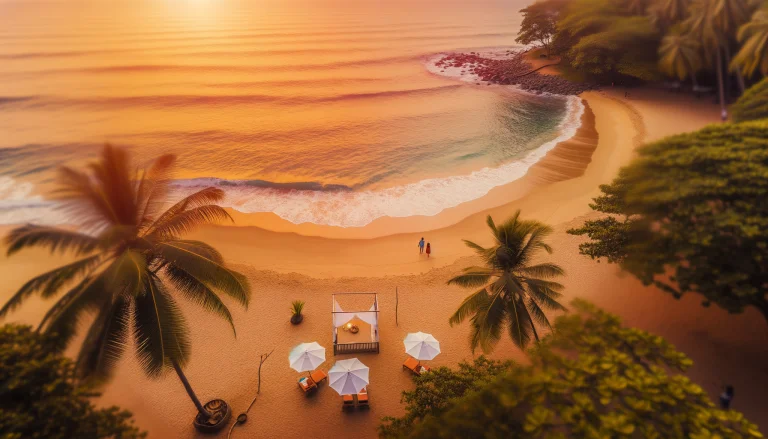Beach Photography Tips: Capturing The Perfect Sunset
Imagine yourself strolling along the golden sands of a picturesque beach with the warm evening sun gently kissing your skin. As you soak in the breathtaking beauty of a mesmerizing sunset, you can’t help but feel inspired to capture this moment forever. Whether you’re a seasoned photographer or a novice armed with a smartphone, this article will provide you with valuable tips and tricks to capture the perfect sunset photograph. From finding the ideal location to understanding the importance of lighting, join us as we explore the art of beach photography and unlock the secrets to creating stunning sunset memories.
Understanding Sunsets
Why sunsets are captivating
Sunsets are captivating because they offer a breathtaking display of colors and beauty that is both soothing and awe-inspiring. There is something inherently magical about watching the sun dip below the horizon, casting a warm glow across the sky. The vibrant hues of oranges, pinks, and purples create a mesmerizing scene that captivates our senses and invokes a feeling of tranquility.
The science behind sunset colors
The science behind sunset colors lies in the way sunlight interacts with the Earth’s atmosphere. When the sun is higher in the sky, its light passes through a smaller portion of the atmosphere, resulting in blue skies. However, during the sunset hours, the sun’s light travels through a larger portion of the atmosphere, and this causes the shorter wavelengths of blue and green light to scatter, allowing the longer wavelengths of red, orange, and pink to dominate the sky.
How location affects sunset hues
Location plays a significant role in the hues and intensity of a sunset. Different geographical features, such as mountains, bodies of water, and even pollution levels, can influence the colors and overall appearance of a sunset. For example, coastal areas are known for their vibrant and colorful sunsets due to the reflection of light off the water’s surface. On the other hand, urban locations with high levels of pollution may produce a hazy and less vibrant sunset. When choosing a location for sunset photography, consider the natural elements that can enhance the colors and atmosphere of your shots.
Choosing the Right Location
Scouting the beach
When it comes to capturing the perfect sunset, scouting the beach beforehand is crucial. Walk along the shoreline and take note of any interesting rock formations, palm trees, or sand dunes that could add depth and interest to your photographs. Look for a stretch of beach that offers unobstructed views of the horizon, as this will allow you to capture the full glory of the setting sun.
The importance of seclusion for minimal distractions
To fully immerse yourself in the beauty of a sunset and maintain focus on your photography, it is essential to find a secluded spot on the beach. This will help minimize distractions from other beachgoers and allow you to be fully present in the moment. Not only will this enhance your photography experience, but it will also give you a sense of tranquility and peace as you watch the sun go down.
Landmarks and how they can enhance your shot
Incorporating landmarks into your sunset photography can add a unique and memorable element to your shots. Look for distinctive structures, such as lighthouses, piers, or beachside cliffs, that can serve as captivating focal points. These landmarks can help provide a sense of scale and perspective, creating a visually stunning composition that tells a story.
Perfect Timing for Sunset Photography
Understanding golden hour and blue hour
Golden hour, also known as magic hour, refers to the period shortly after sunrise or before sunset when the natural light is soft, warm, and golden in tone. This is the ideal time for capturing stunning sunset photos because the lighting creates a warm and romantic atmosphere. Blue hour, on the other hand, occurs shortly before sunrise or after sunset when the sky takes on a deep blue hue. This time is perfect for creating moody and ethereal photographs.
Why time is critical in sunset photography
Time is critical in sunset photography because the lighting conditions change rapidly as the sun moves closer to the horizon. It is essential to arrive at your chosen location well before sunset to allow yourself enough time to set up your equipment and find the perfect composition. As the sun begins to set, the colors and intensity of the sky can change within seconds, making it crucial to be ready to capture the moment.
How daylight savings time may affect your timing
During daylight savings time, the clock is adjusted to provide an extra hour of daylight in the evening. This can affect the timing of your sunset photography, as the sun may set later than usual. Be sure to check the local sunset times and adjust your schedule accordingly to ensure you don’t miss the magic hour.
Advanced Camera Settings for Sunset Photography
Adjusting ISO settings
ISO determines the sensitivity of your camera’s sensor to light. When shooting sunsets, it is generally recommended to use a low ISO setting, such as 100 or 200, to minimize noise and maintain image quality. However, if you need to brighten the scene or capture faster shutter speeds, you can increase the ISO accordingly. Keep in mind that higher ISO settings can introduce noise into your photos, so it’s essential to find the right balance.
Understanding aperture and shutter speed
Aperture and shutter speed are crucial settings for controlling the exposure and depth of field in your sunset photos. For capturing a well-exposed sunset, you can start by setting your aperture to a small f-stop number, such as f/8 or f/11, which will allow more light into your camera. As for shutter speed, it will depend on the amount of movement in your scene. If you want to capture the clouds’ movement, a slower shutter speed, such as 1/30 or 1/60, can create a sense of motion. However, if you want to freeze the action, a faster shutter speed will be necessary.
The role of white balance in catching sunset hues
White balance is an essential aspect of sunset photography as it affects the overall color temperature of your images. To capture the warm hues of a sunset accurately, you can choose the “Cloudy” or “Shade” white balance setting, which adds warmth to your photos. Experimenting with different white balance settings can help you achieve the desired color tones and mood in your sunset photos.
Using Filters in Sunset Photography
Understanding polarizing filters
A polarizing filter can be incredibly useful in sunset photography as it helps reduce glare and enhance colors. By reducing reflected light, a polarizing filter can deepen the blues in the sky, make clouds pop, and remove unwanted reflections from water or glass surfaces. When using a polarizing filter, rotate it to find the optimal position that achieves the desired effect and be mindful of any potential vignetting.
The benefits of neutral density filters
Neutral density (ND) filters are excellent tools for balancing exposure in bright lighting conditions. These filters reduce the amount of light entering the camera, allowing you to use slower shutter speeds or larger apertures. When photographing sunsets, ND filters can help achieve long exposures, creating a dreamy effect by capturing the movement of the clouds and water. Experimenting with different strengths of ND filters will allow you to control the amount of light that enters your camera.
How to effectively use graduated neutral density filters
Graduated neutral density (GND) filters are particularly useful when dealing with scenes that have a significant difference in brightness between the sky and the foreground. These filters have a graduated transition, with one half being clear and the other half being darkened. By placing the darkened portion over the sky, you can balance the exposure between the sky and the foreground, ensuring that both are properly exposed in your sunset photos.
Composition Techniques for Sunset Photos
The impact of framing and angles
Framing and angles can greatly impact the overall composition of your sunset photos. Experiment with different perspectives and find unique vantage points that offer compelling compositions. Consider using natural elements like tree branches or rock formations to frame the sun or add a sense of depth to your image. By changing your shooting position and exploring various angles, you can create visually striking photos that stand out.
The rule of thirds in sunset photography
The rule of thirds is a basic principle of composition that can enhance the visual impact of your sunset photos. Imagine dividing your frame into a grid of nine equal parts by drawing two horizontal and two vertical lines. By placing key elements of your composition along these lines or at their intersections, you create a visually balanced and pleasing image. For sunset photography, consider aligning the horizon or the sun along the bottom or top horizontal line to create a harmonious composition.
Leading lines, symmetry, and patterns
Incorporating leading lines, symmetry, and patterns in your sunset photography can add a sense of visual interest and guide the viewer’s eye through the image. Look for natural elements like paths, shorelines, or a row of palm trees that lead towards the sunset, drawing attention to the focal point. Symmetry can be created by positioning your camera to capture a reflection of the sunset on a calm body of water, while patterns can be found in the formations of clouds or waves. These compositional techniques help create dynamic and engaging sunset photos.
Working with Changing Light
Challenging aspects of catching a sunset
Catching a sunset can pose several challenges due to the rapidly changing light conditions. The color intensity of the sky can vary from vivid to subtle within minutes, making it essential to be prepared and adapt quickly. Additionally, the low light levels during sunset can require longer exposure times, which may result in an increased risk of camera shake. To overcome these challenges, ensure you have a tripod to stabilize your camera and be ready to adjust your camera settings as the light changes.
Adjusting your camera settings as light changes
As the light changes during a sunset, it’s crucial to adjust your camera settings accordingly. By continuously monitoring the exposure and histogram, you can ensure that your photos are properly exposed. Remember to be mindful of any movement in your scene, such as waves or clouds, and adjust your shutter speed accordingly to achieve the desired effect. Additionally, pay attention to the changing colors in the sky and adjust your white balance settings to accurately capture the mood of the sunset.
How to use light reflections to your advantage
During sunset photography, light reflections can serve as fantastic opportunities to enhance your shots. Look for reflective surfaces like water or wet sand to capture the vibrant colors of the sky mirrored beneath. These reflections can create a beautiful and ethereal effect, adding depth and interest to your sunset photos. Experimenting with different angles and compositions will help you find the most captivating reflections and make your images truly stand out.
Post-Processing Sunset Photos
Enhancing colors through editing
Post-processing is an essential step in bringing out the full potential of your sunset photos. However, it’s important to be mindful of not overdoing it. Start by adjusting the exposure and contrast to bring out the details and richness of the colors in the sky. From there, you can fine-tune the saturation and vibrancy to enhance the natural hues of the sunset. Remember to keep the edit subtle yet impactful, aiming to replicate the beauty and atmosphere of the actual scene.
When to use HDR imaging
High Dynamic Range (HDR) imaging can be useful in situations where there is a significant difference in brightness between the sky and the foreground. HDR allows you to capture a wider range of tones by combining multiple exposures into a single image. This technique can be particularly effective during sunset photography, where the vibrant colors of the sky often contrast with the darker foreground elements. HDR imaging helps preserve the details in both the highlights and shadows, resulting in a more balanced and realistic representation of the scene.
How to avoid over-editing your sunset photos
While editing can enhance the visual impact of your sunset photos, it’s important not to over-edit them. It’s easy to get carried away with increasing the saturation or adding filters, resulting in unrealistic and unnatural-looking images. Strive to maintain the authenticity and beauty of the sunset by applying subtle adjustments that enhance the original colors and mood. Remember, the goal is to showcase the natural beauty of the sunset, not to completely alter it.
Consistently Capturing Great Sunset Photos
Revisiting the same location
Revisiting the same location for sunset photography can offer a multitude of benefits. By returning to a familiar spot, you become familiar with the lighting conditions, the best compositions, and any unique features that can enhance your photos. Repeatedly photographing the same location allows you to refine your techniques and capture the subtle changes in the sunset’s appearance throughout different seasons and weather conditions.
Studying weather and seasonal patterns
Understanding weather and seasonal patterns can significantly improve your chances of capturing great sunset photos. Certain weather conditions, such as clear skies or the presence of clouds, can create different moods and color palettes. Pay attention to weather forecasts and look for opportunities where you can capture unique and dramatic sunsets. Additionally, explore how the changing seasons affect the position of the sun and the overall ambiance of your photos.
Practicing patience in photography
Patience is key in sunset photography. Sometimes, the most stunning sunsets can take time to develop, and you may need to wait for the perfect moment to capture the magic. Use this time to observe and connect with nature, embracing the serene environment around you. Remember, the more patient and present you are, the higher your chances of capturing a remarkable sunset photo.
Additional Factors to Consider in Beach Photography
The role of weather
Weather plays a significant role in beach photography, particularly during sunset shooting. Cloud cover can add drama and texture to your images, while clear skies can provide a vibrant and colorful backdrop. Pay attention to the forecast and use it to your advantage to capture the mood and atmosphere you desire. Be prepared for unexpected weather changes and adjust your plans and camera settings accordingly.
Practical considerations (sand, water, etc.)
Beach photography comes with its own set of practical considerations. When shooting sunsets, be mindful of the sand, which can easily get into your gear. While changing lenses or accessing your camera’s settings, find a clean and sheltered area to avoid any sand damage. Additionally, be cautious of the water’s edge and waves, which can quickly soak your equipment or cause slip hazards. Taking these practical considerations into account will help keep you and your gear safe while shooting.
Safety precautions during sunset beach shooting
Safety should always be a top priority, particularly when photographing sunsets on the beach. Stay aware of your surroundings, including the tide movements and the potential for large waves. Never turn your back to the ocean, as unexpected waves can pose risks, especially during high tide or stormy conditions. If you plan to venture onto rocks or cliffs for a better vantage point, take caution and ensure stable footing. Always prioritize your safety above capturing the perfect shot.
In conclusion, capturing the perfect sunset photo requires a combination of careful planning, technical knowledge, and artistic vision. By understanding the science behind sunsets, choosing the right location, mastering camera settings, utilizing filters, applying composition techniques, and working with changing light, you can consistently capture stunning sunset photos. Remember to embrace the beauty of nature, be patient, and practice safety precautions during your beach photography adventures. So grab your camera, head to a picturesque beach, and immerse yourself in the magical world of sunset photography.







